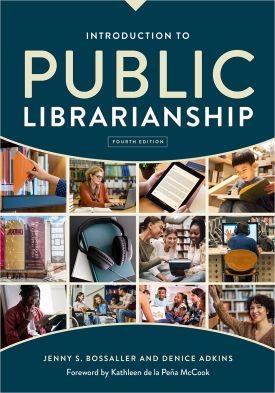
Primary tabs
You don't need to be an ALA Member to purchase from the ALA Store, but you'll be asked to create an online account/profile during checkout to proceed. This Web Account is for both Members and non-Members. Note that your ALA Member discount will be applied at the final step of the checkout process.
If you are Tax-Exempt, please verify that your account is currently set up as exempt before placing your order, as our new fulfillment center will need current documentation. Learn how to verify here.
- Description
- About the authors
Foreword by Kathleen de la Peña McCook
Exhaustively researched and expansive in its scope of topics both traditional and timely, this updated text continues to serve both LIS students and current practitioners.
Dubbed "a peerless ambassador for public libraries, educating future professionals, current professionals in other parts of the field, and anyone else interested about the irreplaceable and irrepressible entities that are public libraries” (Library Quarterly), the newest edition of this trusted resource has been reimagined and restructured to make it even more relevant and useful. The definitive handbook on this branch of the profession, it covers every aspect of the public library, from its earliest history through its current incarnation on the cutting edge of the information environment, including
- a summary of current and historical issues in public libraries;
- a new chapter on financing which covers traditional sources, creative funding, capital campaigns, special projects, and the pros and cons of public/private partnerships;
- statistics, standards, planning, evaluations, and results;
- legal issues and politics, including how different states are set up, the role of state libraries, defining service population, and when the law and values conflict (such as union/non-union scenarios);
- updated coverage of important advocacy issues, including advocacy for access, the legal limits of advocacy, involving the community in advocacy, and communicating the effectiveness of the public library to stakeholders;
- organization, administration, and staffing, from the differences between small libraries and large systems to current issues like non-MLIS library workers and unionization;
- learning about who public libraries serve by utilizing community analysis, community needs assessments, and diversity considerations;
- adult services, youth services, children's services, and serving special populations such as older adults, adults with special needs, schools, daycares, and the incarcerated;
- library technology, from structure and infrastructure to websites and makerspaces;
- issues related to library buildings and master plans, such as gathering community input and working with an architect on library spaces and library services outside of the library;
- library associations, state library agencies, and other professional organizations;
- disaster planning and recovery from technological, ecological, and biological disasters; and
- global perspectives on public libraries.
Examination copies are available for instructors who are interested in adopting this title for course use. An e-book edition of the text will be available shortly after the print edition is published. An online resource supplements the print edition with teaching materials (slidedecks, discussion prompts, suggested readings, and relevant reports) as well as links to updated research data from IMLS.
Jenny S. Bossaller
Jenny S. Bossaller is Associate Professor at the University of Missouri's School of Information Science and Learning Technologies. She earned her MA in Library Science in 2005, worked at the MOBIUS consortium from 2005 - 2008, and earned a PhD in Information Science and Learning Technologies in 2010. She has been active in state, national and international conferences and committees, including Missouri Library Association (MLA), ALA, ALISE, ASIS&T, and IFLA. She has served on the editorial board of RUSQ for the past four years. Her scholarship covers a wide range of topics, such as free speech, public librarians' role in the Affordable Care Act, library management, equity, education, indigenous knowledge, and reference work. Her teaching focuses on information access, public libraries, and intellectual freedom. She is the co-PI on the Public Library Leadership (PuLL) project, which aims to develop new public librarian leaders with an awareness of community needs, and which involves work with many public librarians across Missouri.
Denice Adkins
Denice Adkins, PhD, Professor, School of Information Science & Learning Technologies, University of Missouri Columbia. Denice’s research and teaching focuses on public libraries, services for the Latinx and other communities, and reading. She has served as president of REFORMA (The National Association to Promote Library & Information Services to Latinos and the Spanish-Speaking), an ALA Councilor-at-Large, Fulbright Scholar to Honduras, and Fulbright Specialist in India.


